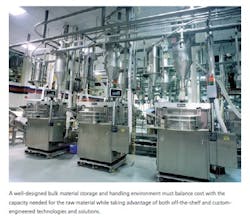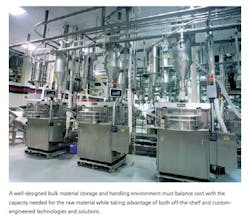Any process that manufactures a biotherapeutic, biodiagnostic, or other bio-based solution requires a well-designed bulk material storage and handling environment. Without such technology, the manufacturing process can be sidelined by raw material breakdown, spoilage, exposure to moisture or contamination or pest infestation. Assuring the reliability of a storage and conveyance environment is based on four key concepts:
1) A well-designed storage container system
2) Effective climate control
3) Smooth conveyance of the material in and out of the container
4) Cleanability for quality assurance and operational efficiency
A WELL-DESIGNED SILO
A well-designed bulk material storage and handling environment must balance cost with the size needed for the raw material. Containers must be large enough to achieve economies of scale, and to allow easy emptying and refilling, and its surfaces must be compatible with the characteristics of the raw material. Striking this balance requires an integrated assessment of the plant, its site and the material to be contained.
Unfortunately, there are currently no universally accepted design standards for the bulk material storage and handling environment. Although many equipment vendors provide a turnkey package — silo, peripheral equipment and design — there are pitfalls to this type of solution. Shortcomings with this approach include oversimplification, which can result in system performance issues and also a tendency to use standard or off-the-shelf solutions, which may not provide the best solution. An experienced bioprocess engineer can offer a custom design that meets the unique operational needs of the owner and facility.
First of all, bin activation and fluidizing systems must be configured to match the characteristics of the raw material. If the owner or vendor can provide the material’s physical characteristics, great. If not, materials testing will be needed to determine the material’s angle of repose, its hygroscopic parameters and particle size, all of which are related to flow.
Some raw materials flow easily out of a cone bottom, whereas others tend to bridge and obstruct free flow. An example of the latter is soy meal, which forms clumps when damp. To keep the material dry, the silo’s designer can envelop the silo in dehumidified air and use air pads on the silo’s cone bottom to facilitate flow.
Other bio-based materials require bin activation using a vibratory or a screw conveyor. Unfortunately, if the system can’t be easily cleaned, the raw material may build up, especially at transition points. In that situation, fluidizing may be a better solution. Solimar Pneumatics, for example, offers a fluidizing disk that is compact, self-cleaning and economical.
A design consideration that is equally critical to flow maintenance is the interface between the container’s surface and the contained material. Given a corrosive material such as urea, for example, stainless steel would unquestionably make a more durable and cleanable containment surface than fiberglass. Furthermore, using stainless steel may be the most cost-effective choice in the long run. It is far less likely to need replacing if the process will be using a corrosive raw material in the future.
The next design challenge to consider is the conveyance of the bio-based material into and out of the silo. If the material is subject to molecular decomposition or other damaging transformation, the process engineer must be careful with the design of any pneumatic conveyance. It has an inherent tendency to abrade or heat the material. With such materials, the engineer must not allow too high of a conveying velocity. He or she must also use appropriate piping components and employ cooling heat exchangers in the conveying air stream.
The climate control system of a container must be designed around the susceptibility of the raw material to humidity, airborne microbes and extreme temperature. To prevent a hygroscopic material from absorbing water and clumping or degrading, humidity must be kept low. Sugars, for example, are very hygroscopic and can easily clump and interrupt flow. For materials that are vulnerable to microbes engineers can use HEPA filtration or UV treatment of the air in the top of the bin. Temperature control is obligatory for heat-sensitive materials such as glucose.
Cleanability is important for reasons of safety and performance. A clean system prevents contamination by microorganisms, insects, rodents and other animals. A clean system protects the flow of material against clumping or dredging. An effective design streamlines both the container and conveyance system to limit transition points. When transition points cannot be eliminated, they should be designed with maximum bending radii so that material flows smoothly and does not build up.
Good cleanability can also avoid the need for extra steps. For example, many bioprocess manufacturers will, as a hedge against contamination in unreliable storage conditions, heat a slurry to sterilize it before adding it to their fermenters. Proper system design may eliminate certain sterilization steps, which can reduce operating cost and improved quality control. Finally, the system’s design must allow operators to take its components apart and reassemble them quickly by hand. This keeps downtime for cleaning and maintenance to a minimum.
REAL-WORLD SOLUTIONS
Innovative solutions for containment and conveyance can confer benefits well beyond protecting the integrity of bio-based materials. They can also reduce costs, compress the construction and installation schedule, improve quality control and enable expansions to be completed while maintaining production. In the following cases, strategies included holistic assessment, the use of carefully selected “off-the-shelf” equipment and prefabricated components, and the expansion of storage capabilities while maintaining operation:
Looking first at the entire process. How did a bioprocessing firm that uses soy meal in a fermentation system to produce an enzyme achieve a technically sound and cost-effective climate control system? It combined a thorough needs and site assessment with the transfer of knowledge from the food industry. Although the end-product of this process is not used for human food production, bioprocess engineers with SSOE Group designed the storage environment as if its contents were intended for human consumption. Going this extra mile reflected SSOE’s respect for the potential negative impact of contaminating a batch of expensive product.
In this case, the soy meal was received in bulk and stored in a bin. Although it was not especially sensitive to degradation, humidity and the resultant clumping were still problematic. The conventional solution? A cooling coil and reheat coil system, or a desiccant system. However, because this manufacturer used dry nitrogen in other parts of its process, the SSOE engineers designed a dry nitrogen purge system to control humidity within the ideal range. The capital outlay for this innovation was one-third that of the conventional cooling or drying technology.
Using small containers and off-the-shelf equipment for an offshore pilot plant. Practical and economic constraints created challenges for SSOE process engineers when asked to design a raw material storage and handling system for a biofuel pilot plant at an offshore location. Both the equipment for the plant and the raw materials were to be delivered by container ships. The engineers’ solution enabled the owner to use bulk bags, totes and drums, and it incorporated off-the-shelf equipment to handle dumping, pumping out, emptying and hanging these containers.
It was elegant simplicity. Bulk bags arrived by ship; fork trucks unloaded and delivered bulk bags to the storage and handling area; the bags were hung on an emptying station; contents were emptied into a conveying system; and raw materials were conveyed to a slurry-mixing tank. In addition to handling the raw material, the solution minimized capital cost, achieved cleanability and optimized efficiency. There is no master specification for such equipment. Because this was a pilot plant, the engineers also maximized its flexibility to safely process new and possibly more corrosive materials in the future.
Pre-fabricate to reduce cost, accelerate schedule and improve QC. Another manufacturer had to double its plant capacity, including raw material storage, to keep pace with forecasted market trends. With the plant remaining in operation, SSOE completed the project in 11 months. To do this, the engineering firm partnered with two contractors to execute a design-build plan that used prefabricated components. While one contractor worked on slip forms for the silos, the other worked on the conveying system using prefabricated pipe and other components. Tie-ins were made during scheduled process shutdowns. The parallel team approach not only cut 25% off the original construction schedule, it improved QC because shop fabrication allowed greater control conditions.
In the bioprocessing industry, well-designed bulk material storage and handling environment are essential in preventing raw material breakdown, spoilage, exposure to moisture or contamination or pest infestation. The components of such an environment include: a well-designed silo or other storage container system; effective climate control; smooth conveyance of the material in and out of the container; and cleanability for quality assurance and operational efficiency. When innovative thinking is combined with a technically sound design, the result can save bio-processor’s time, trouble and money.
Mark Hoffman, PE, is an engineering manager at SSOE Group (www.ssoe.com). He has more than 30 years of experience in project/engineering management in many industries. Hoffman can be reached at 651-726-7660 or [email protected].
Published in the November 2013 edition of Pharmaceutical Manufacturing






